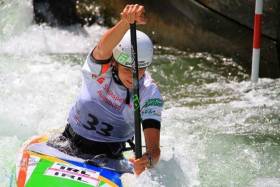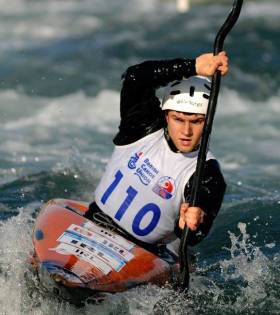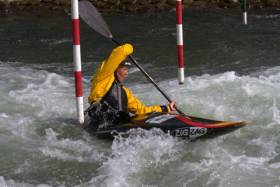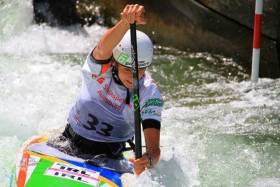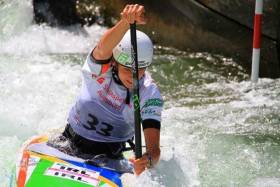Displaying items by tag: canoe slalom
Middle Section Costs Jegou in Canoe Slalom World Final
#Canoeing: Ireland's Liam Jegou finished ninth in the Under-23 C1 at the canoe slalom World Championships this morning. The 20-year-old went off second last in the final in Krakow in Poland and set a time of 94.62 seconds. He lost time in the middle section of the course, touching gate 14 and so incurring a two-second penalty. Florian Breuer of Germany had set a time of 87.88 early in the final and it was not matched. He took gold; Lukas Rohan of the Czech Republic silver and Russia's Kirill Setkin bronze.
Canoe Slalom World Championships (Irish interest)
Men
Under-23 C1 Final: 1 Germany (F Breuer) 87.88, 2 Czech Republic (L Rohan) 89.06, 3 Russia (K Setkin) 90.43; 9 Ireland (L Jegou) 94.62.
Superb Performance Puts Jegou Into Canoe Slalom World Finals
#Canoeing: Liam Jegou qualified for the final at the canoe slalom World Championships in Krakow this morning. Going off last of the 20 qualifiers for the semi-final, with a high standard already set, Jegou knew he had to produce a good performance. He put in a superb fault-free run to finish second. His time of 90.48 seconds was just .27 off the top time.
Canoe Slalom World Championships, Under-23 and Junior, Krakow, Poland (Irish interest)
Men
Under-23 C1 Semi-Finals (10 qualify): 2 L Jegou 90.48 seconds.
Curtis Left To Rue Close Call at World Championships
#Canoeing: Sam Curtis was left to rue his close miss in the first run of the under-23 K1 at the canoe slalom World Championships in Krakow in Poland. The Irishman had to wait around for a protracted period as a technical issue was sorted out in the middle of the second run, and he did not do well. He touched five gates and missed one – gate 11. He was well outside the qualifying mark for the semi-finals. Noel Hendrick and Eoin Teague also missed out.
Canoe Slalom World Championships, Under-23 and Junior, Krakow, Poland (Irish interest; selected results)
Men
Under-23 K1 (racing kayak) – First Run (Top 30 Qualify): 35 S Curtis 86.08; 69 E Teague 137.71; 70 N Hendrick 138.45. Second Run (10 Qualify): 22 Hendrick 94.34; 35 Teague 137.21; 38 Curtis 144.47.
Junior K1 – First Run (30 Qualify): 50 S Ansell 110.33; 63 C McLarnon 150.29; 74 C Vaugh 214.05. Second Run: 28 Ansell 109.79; 38 Vaugh 148.67; 44 McLarnon 185.63.
Women
Under-23 K1 – First Run (15 Qualify): 30 C O’Ferrall 156.80. Second Run (5 Qualify): 23 O’Ferrall 251.16.
#Canoeing: Liam Jegou topped the rankings in his first run and qualified directly for the semi-finals at the canoe slalom under-23 World Championships in Krakow in Poland. The Ireland C1 competitor had a fault-free round in 83.55 seconds. Ireland’s two other contenders in this class fell outside the qualificaton mark: Robert Hendrick missed gate 10 and incurred a 50-second penalty in an otherwise steady run. Jake Cochrane touched gates 12 and 14 and then missed gates 17 and 18, to finish 60th. Hendrick finished 15th in his second run and Cochrane 27th.
Canoe Slalom World Championships, Under-23 and Junior, Krakow, Poland (Irish interest; selected results):
Men
Under-23 C1 – First Run (20 qualify directly for semi-finals): 1 Ireland (L Jegou) 83.55 seconds; 54 R Hendrick 141.89; 60 J Cochrane 200.64. Second Run (10 qualify): 15 Hendrick 94.87; 27 Cochrane 100.74.
Junior C1 – First Run (20 qualify): 41 Ireland (E Moorhouse) 120.92; 49 F McNally 164.94. Second Run: 20 McNally 113.71; 34 Moorhouse 162.06.
Jegou Gives Best But Misses Olympic Qualification
#Canoeing: Ireland’s Liam Jegou finished 19th in the semi-finals of the canoe slalom European Championships this morning. Jegou came down the course at Liptovsky Mikulas in Slovakia in 105.02 seconds. He had touches on gates one, nine and 20, thus incurring six seconds on penalties. His time of 111.02 put him fourth at that point – crucially .2 of a second behind Italy’s Raffaello Ivaldi, so ruling out the Irishman taking the top place amongst those countries who had not qualified for the Olympics.
Ander Elosegi of Spain qualified that country for the Olympic Games. He finished sixth in 104.18 – the first boat from a country not already qualified. Elosegi qualified for the final and should Jegou have also qualified, the two would have had to shoot it out on Sunday.
Canoe Slalom European Championships, Liptovsky (Irish interest, selected results) – Day Two
Men
C1 – Semi-Finals: 1 Germany (S Tasiadis) 99.79; 19 Ireland (L Jegou) 111.02 seconds (incl 6 sec pen)
No Joy for Craig at European Championships
#Canoeing: Hannah Craig’s chances of Olympic qualification disappeared as the K1 competitor failed to make the semi-finals of the canoe slalom European Championships in Slovakia. The Antrim woman, who had finished 10th in London in 2012, negotiated the course in 111.59 seconds, including four seconds of penalties, in the first run. This placed her 28th. Her second run gave her another chance, but she missed the final two gates, incurring 100 seconds in penalties, and missed out.
Liam Jegou Qualifies for European Semi-Finals
#Canoeing: Liam Jegou qualified for the semi-finals of the canoe slalom European Championships in Liptovsky Mikulas in Slovakia this morning. A second run of 98.33 seconds with no touches put the 20-year-old through in the C1 category. His first run of 105.36, with a two-second penalty on gate six, had placed him 29th and eight places outside qualification, but his second run was much better. If Jegou can do well enough in the succeeding rounds so that his boat is the first from a country not already qualified for the Olympic Games, he will secure a place in Rio de Janeiro.
Liam Jegou Impresses at Irish Open in Lucan
#Canoeing: Liam Jegou (20) took until his second run to master a tough course at the canoe slaolm Irish Open at Lucan today. The C1 competitor lowered the time of his first run by over 10 seconds, setting a winning mark of 90.81 seconds. Mike Kurt, the Swiss international who set the pace in the K1, also struggled on his first run on a course where two upstream gates below the sluice tested all the competitors. Kurt nailed it on the second run, with the best penalty-free time of the day – 89.08 seconds. Ciarán Heurteau, recovering from injury and a break from the sport, was the best Ireland senior competitor, being credited with 95.01 seconds, which included four seconds in penalties. Sam Curtis was bang in form at under-23 level: his first run was a winning one of 90.56 seconds. He bettered the time in the second run (88.64) but was adjudged to have touched one gate and missed another, so incurring 52 points in penalties.
Hannah Craig was the top woman competitor in the senior K1, while Caoimhe O’Ferrall set an excellent time of 121.92 in the C1, though she is just 18.
Canoe Slalom Irish Open, Lucan, Sunday (Selected Results)
Men
K1 – Senior: 1 M Kurt 89.08, 2 C Heurteau 95.01, 3 P Hynes 110.55. Under-23: S Curtis 90.56. Under-18: L Palmer 105.42. Masters: A Boland 114.79. Vets: G Collins 135.86.
C1 – Under-23: 1 L Jegou 90.81, 2 R Hendrick 99.25, 3 J Cochrane 101.34. Under-18: E Moorhouse 124.24. Under-16: F McNally 121.7
Women
K1 - Senior: H Craig 109.13. Under-23: G Ridge 108.5. Under-18: M Hamer Evans 109.06. Under-16: K Davidson 128.4.
C1 - Under-23: C O’Ferrall 121.92.
Liam Jegou Excels in Second Run to Claim Semi-Final Place at World Championships
#Canoeing: Liam Jegou qualified for the semi-final of the canoe slalom World Championships in Lee Valley, England today. The France-based teenager produced an impressive, penalty-free, second run in the C1 to place ninth, with 10 places available. In his first run, he incurred penalties on gates eight and 11 and had four seconds in penalties, but would have fallen outside qualification in any case. Jake Cochrane placed 68th and 64th in his two runs.
Canoe Slalom World Championships, Lee Valley, London, Day Two (Irish interest)
Men
C1 – First Run (top 20 to semi-finals): 37 L Jegou 95.98 seconds (incl 4 sec pen); J Cochrane 161.15 (incl 54 sec pen). Second Run (10 qualify): 9 Jegou 90.83; 64 Cochrane 108.38 (incl 8 sec pen).
Women
C1 – First Run (top 15 to semi-finals) 32 C O’Ferrall 191.62; Second Run: O’Ferrall 132.14 (incl 4 sec pen)
Craig One Touch From Semi-Final at World Championships
#Canoeing: Ireland’s Hannah Craig came close, but missed out on qualifying for the semi-finals of the women’s K1 at the canoe slalom World Championships in Lee Valley in England today. She came down the course in 97.04 seconds on her first run, but a touch on gate 11 took her to 99.04 seconds, and pushed her out of the top 20, who qualified. The second run had just 10 qualifying places available. Craig finished 21st, with a penalty-free run of 100.4 seconds.
Canoe Slalom World Championships, Lee Valley, London, Day One (Irish interest)
Women
K1 – First Run (20 qualify): 30 H Craig 99.04 seconds (incl 2-sec penalty); 2nd Run (10 qualify): 21 H Craig 100.4 sec.



























